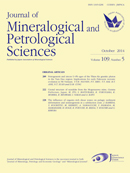All issues

Volume 109 (2014)
- Issue 6 Pages 109C1-
- Issue 5 Pages 209-
- Issue 4 Pages 157-
- Issue 3 Pages 109-
- Issue 2 Pages 49-
- Issue 1 Pages 1-
Volume 109, Issue 5
October
Displaying 1-3 of 3 articles from this issue
- |<
- <
- 1
- >
- >|
ORIGINAL ARTICLES
-
Thuy Thi Bich NGUYEN, Pham Trung HIEU, Tran Thanh HAI, Bui The ANH, Ng ...2014Volume 109Issue 5 Pages 209-221
Published: 2014
Released on J-STAGE: October 31, 2014
Advance online publication: October 09, 2014JOURNAL FREE ACCESS
Supplementary materialGranites of the Thien Ke pluton that are exposed in the Tam Dao region are of sub–alkaline affinity, belong to the high–K calc–alkaline series, and display typical features of S–type granite. The rocks have high ASI values of 1.14–1.41 and are characterized by high initial 87Sr/86Sr ratios (0.7264–0.7270) and low εNd (456 Ma) values (−6.5 to −8.4). All of these characteristics, combined with ~ 1.8 Ga TDM model ages and low Mg# of 13–22, suggest an origin in the partial melting of crustal source rocks. LA–ICP–MS zircon U–Pb analytical results from two samples revealed emplacement ages of the granite at 456 ± 28 and 449 ± 12 Ma. These ages are entirely different from those reported in earlier publications and indicate the existence of a Caledonian tectonothermal event in the study area. The Nd–Sr isotopic data, in conjunction with inherited zircon ages (721–1876 Ma), imply Paleoproterozoic to Neoproterozoic crustal material as the major components of the underlying basement. The new geochronological data provide evidence for early Paleozoic magmatism in the Tam Dao region, which has not been previously identified.View full abstractDownload PDF (3214K) -
Miku ITO, Satoshi MATSUBARA, Kazumi YOKOYAMA, Koichi MOMMA, Ritsuro MI ...2014Volume 109Issue 5 Pages 222-227
Published: 2014
Released on J-STAGE: October 31, 2014
JOURNAL FREE ACCESS
Supplementary materialSuzukiite from the Mogurazawa mine, Gunma Prefecture, Japan exhibits orthorhombic space group Cmcm, a = 5.3546(16), b = 15.249(5), c = 7.094(2) Å, Z = 2. Electron microprobe analyses yielded the empirical formula (Ba0.977Sr0.027)Σ1.004V1.013Si1.985O7. The crystal structure was refined to R = 0.0211. The crystal structure of suzukiite comprises BaO11 polyhedra, SiO4 tetrahedra, and VO5 square pyramids. The Si4O12 chain runs parallel to the c axis, and the VO5 square pyramids link the chains to form a layer parallel to the ac plane. Ba atoms are located in the interlayer region and stack alternatively with the silicate–vanadate layers. The coordination of Ba in suzukiite is considerably distorted owing to the tight framework of the silicate–vanadate layer. The b length of the unit cell of suzukiite is larger than that of haradaite, the Sr analogue, whereas the a and c lengths show no remarkable difference.View full abstractDownload PDF (1809K) -
Jun KAMEDA, Yui KOUKETSU, Mayuko SHIMIZU, Asuka YAMAGUCHI, Yohei HAMAD ...2014Volume 109Issue 5 Pages 228-238
Published: 2014
Released on J-STAGE: October 31, 2014
JOURNAL FREE ACCESSWe have examined the mineralogy and deformation of black shear zones containing abundant carbonaceous materials (CM) and clay minerals in bedded ribbon cherts in a Jurassic accretionary complex, central Japan. Microtextural observations indicate that pressure solution and cataclastic deformation were the primary deformation mechanisms in the cherts. Whole–rock mineral compositions were quantitatively investigated using X–ray diffraction, Raman spectroscopy, and a CHN elemental analyzer. The results show that the samples contain variable amounts of CM and clay minerals, up to 17 wt% and 60 wt%, respectively. Moreover, the clay and CM contents in the samples, including the host rock cherts, show a positive correlation represented by a single compositional trend, and this may be explained by the progressive concentration of clays and CM due to pressure solution and the removal of soluble quartz or mass transfer processes associated with deformation. Intact cherts dominated by quartz seem to provide plausible source rocks for the nucleation of seismic slip including slow slip events, while the abundant CM and clays as observed in the black shear zones may have effectively weakened and stabilized the sliding behavior. These results are important for understanding deformation processes in the Japan Trench.View full abstractDownload PDF (5577K)
- |<
- <
- 1
- >
- >|